
Moraine Lake in Banff National Park, Canada (North of Glacier Park, in the US.) The tree line is at about 2,300 m (7,500 ft). Above, the rugged mountains are primarily rocks and ice. Rivers cut through deep canyons. Photo courtesy of ©Parks Canada / Banff National Park.
Final Report on the Plains Bison Reintroduction Pilot 2017-2022
Executive Summary, May 2023
Following the 2015 Plains Bison Reintroduction Plan, Parks Canada prepared a draft Report on the Plains Bison Reintroduction Pilot 2017-2022 (the Report).
The Report summarizes key learnings of the five-year pilot and was shared with Indigenous Peoples, stakeholders and the public for comment over a 30-day engagement period between November 9th and December 14th, 2022.
During the engagement period, Parks Canada sought feedback on results of the pilot and input on what is important for Parks Canada to consider in the future of bison management in Banff National Park. All comments received were documented, read and analyzed.
In total, Parks Canada received 56 responses ranging from personal accounts of the importance of the bison reintroduction to specific recommendations to improve the draft Report.
Input was received from individuals (Canadians at large), organizations (environmental, industry, recreation, research) and Indigenous Peoples, many of whom had been previously engaged in earlier phases of the pilot.
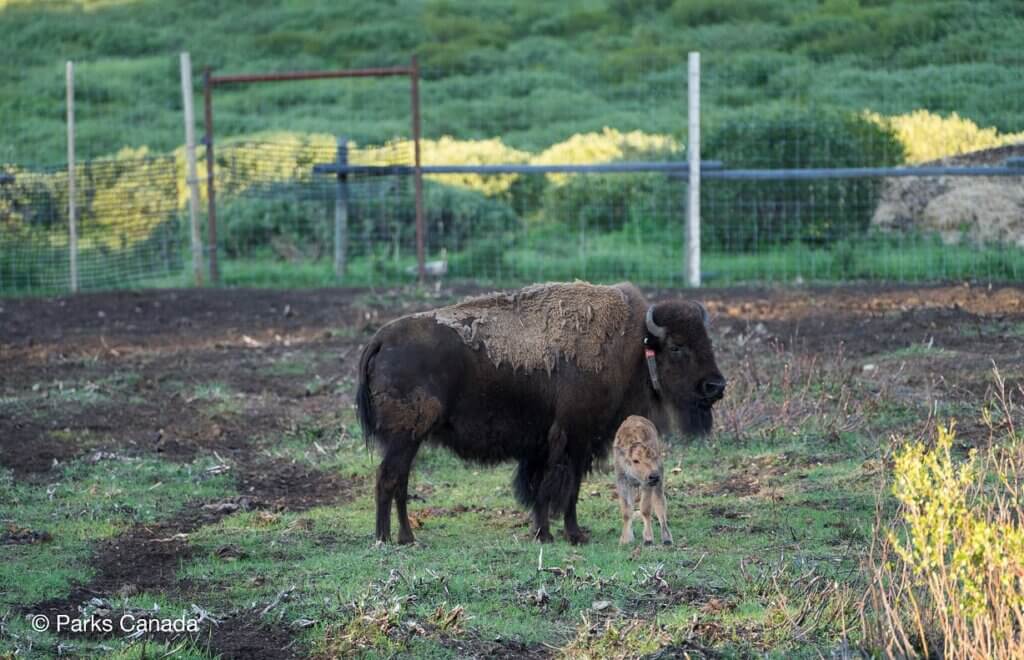
Of all the advice received from bison ranchers . . . and reintroduction experts, the single most important way to bond buffalo to their new home was to have them calve successfully in the new location. The first two years they calved within the smaller re-location pasture. Photo ©Parks Canada / Banff National Park.
Overall, feedback indicates the pilot was a success and there is a strong support for bison to remain on the landscape, with variations in what that may look like in the future.
Major themes that emerged include:
- Indigenous Connection:
Bison hold spiritual importance and enduring cultural, historical and traditional significance to Indigenous peoples.
- Sustainable Management:
The healthy and growing bison herd should be sustainably managed through long-term planning and operations.
- Collaboration:
Continued inter-jurisdictional and partner collaboration will be critical to maintaining and managing bison on the landscape.
- Benefits to Biodiversity:
The bison herd have been observed to positively interact with
The environment and other species over the course of the pilot, resulting in benefits to the surrounding ecosystem and its biodiversity.
- Visitor Education:
Visitor experiences should focus on educational opportunities about
The importance and role of bison, including keeping bison wild and human-wildlife interaction safety.
Results of engagement are further summarized below and have helped Parks Canada finalize the Report. Comments have also been considered in next steps, including the decision to develop a bison management plan. Parks Canada is grateful and thanks all those who participated.
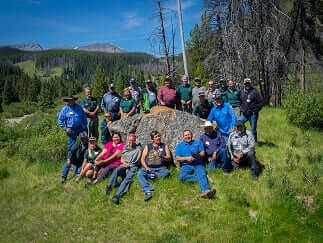
Reintroduction of bison included a Blessing Ceremony with staff and Indigenous people in Banff National Park. Photo ©Parks Canada / Banff National Park.
What We Heard
Over a 30-day engagement, Parks Canada sought input from Indigenous Peoples; other levels of government; environmental non-governmental organizations (ENGOs); scientists and researchers; hunting outfitters and trappers; tourism operators; the livestock, ranching, and grazing industry; recreationalists; and Canadians.
Parks Canada communicated about engagement opportunities via email, letter, newspaper announcement, website announcements, social media postings and in-person and virtual discussions.
In total Parks Canada received 56 responses as either written submissions or verbal comments in meetings, representing a variety of perspectives.
Input ranged from personal accounts of positive encounters with the bison in the backcountry to reflections on how Parks Canada should manage the growing population of the bison in the future and recommendations on how to improve the Report.
The vast majority, 91% of comments, expressed clear support for continued bison presence on the landscape, with a variety of comments as to what the future should look like.
The following is a high-level summary of what we heard on a variety of key topics.
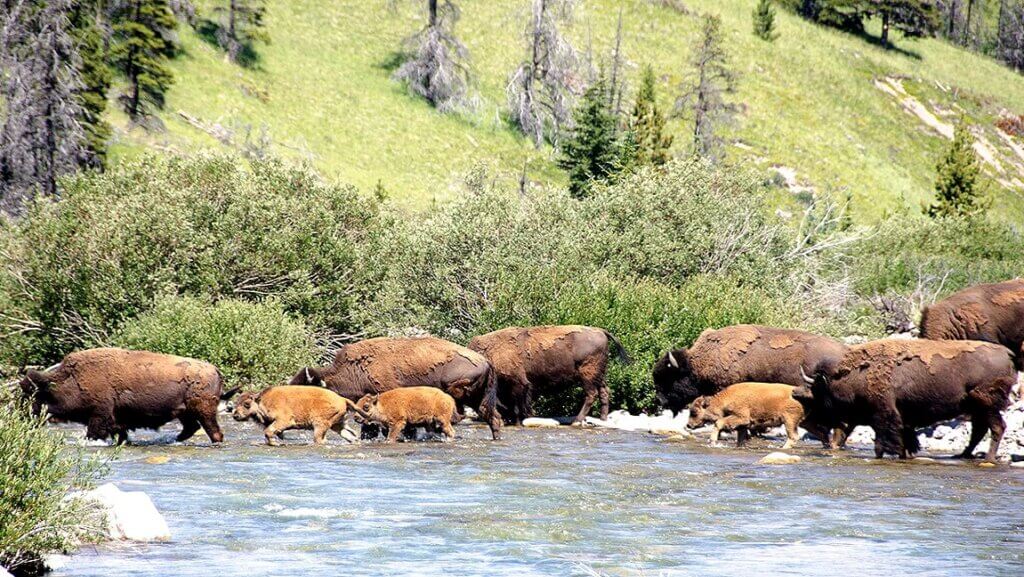
Cows and calves raised with water in tanks cross a river for first time. Photo ©Parks Ca nada / Banff National Park.
Strong Support: For Future with Bison on the Landscape
The majority of public and stakeholder comments strongly supported a future with bison on the landscape with an emphasis on continuing to build on the success of the pilot.
Indigenous Peoples we heard from also strongly supported a future with bison.
Stakeholders who previously expressed concerns about public safety, the potential for property damage and harm to livestock were well represented in this engagement process and indicated their concerns were addressed or decreased because of the management and results of the pilot.
Some Concerns Remain
In the few instances where opposition to bison on the landscape was voiced, the concerns centred around the perceived potential for human-wildlife conflict, negative side-effects to the local landscape and the incompatibility of bison with current user activities in and around Banff National Park.
The potential for risk to livestock and property outside the national park was a continuing concern for the agricultural sector but decreased notably since before the pilot.
This sector also expressed strong appreciation for how Parks Canada honoured its commitments to test bison for disease and to haze or recapture the few bison that ventured beyond the reintroduction zone during the pilot.
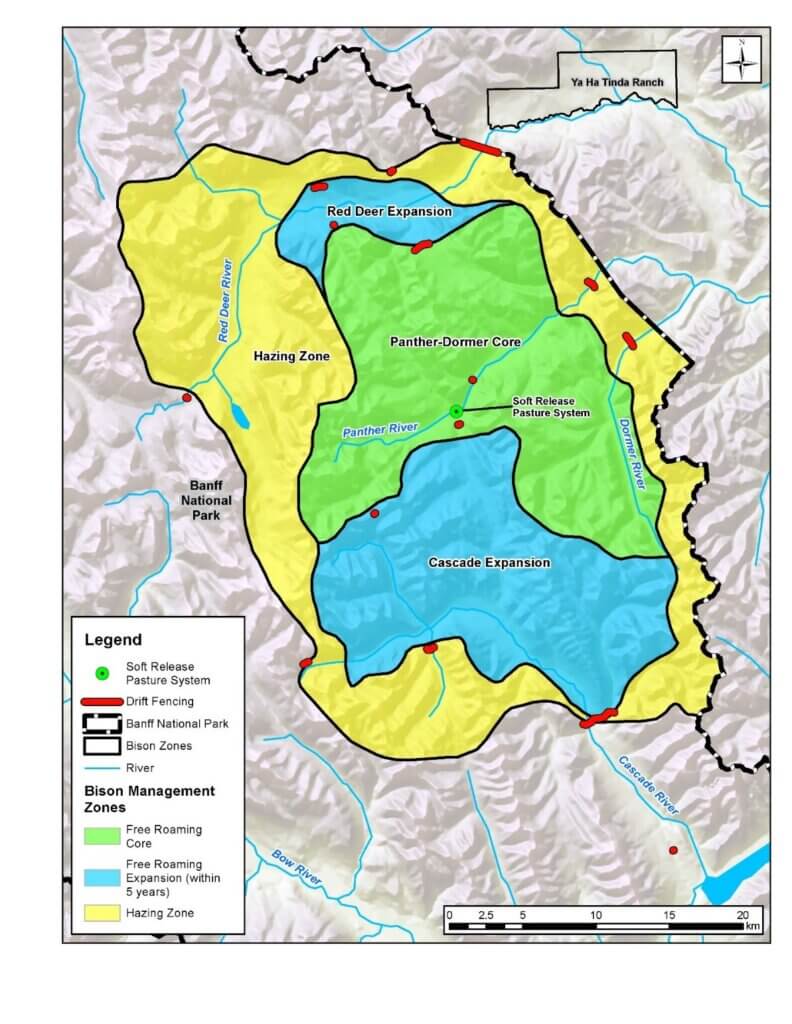
The Panther and Dormer River Valleys in the eastern part of Banff National Park form the core of the initial reintroduction zone (green area), spanning 1200 km2 (463 mi2). Within this is the small Soft Release Pasture System (green dot). During the 5 years the Red Deer and Cascade Expansions (blue) were added. The Hazing Zone is yellow. Short stretches of wildlife-friendly drift fencing (red) encourage bison to stay within the reintroduction zone—while allowing other wildlife to pass safely in and out of the park. Map courtesy ©Parks Canada / Banff National Park.
On Managing the Reintroduction Herd
Population Management
Several respondents expressed carefully considered and detailed views on future management of the reintroduction herd, including concerns with how management of the growing population is achieved.
Many Indigenous groups, stakeholders and members of the public support managing the bison population because of the level of growth of the herd so far and the projections of herd size.
A high number of respondents stressed that natural and sustainable ways to manage the population are important for Parks Canada to consider in the future, with many recommending expansion of the bison’s range.
ENGOs voiced sentiments that bison should be monitored and populations managed in sustainable ways, but not contained or restricted.
A small but notable group of respondents support population management tactics consistent with those employed during the pilot.
This was particularly important to members of the agricultural sector who recommended long-term population management is achieved within available habitat in Banff National Park, and that similar management mitigations as utilized during the pilot are employed (i.e., Bison Excursion Response Plan and the Bison Health Monitoring and Disease Response Plan).
Planned Harvesting
Approximately a third of respondents support planned harvesting as a sustainable method for population management. Most of these commenters further explained that opportunities for traditional harvesting by Indigenous Peoples was why they would support this approach.
Many who advocated for this approach also associated harvesting with an expanded bison area, with regulated harvests taking place outside of Banff National Park to provide increased access.
Cultural Significance: Enduring Cultural Significance to Indigenous Peoples
Over half of all feedback RECOGNISED bison as an animal of seminal connection, interest and meaning to Indigenous Peoples. Parks Canada heard overwhelmingly that the Banff bison reintroduction has spiritual resonance, historical and traditional associations and enduring cultural significance to Indigenous Peoples.
Input also spoke to the reintroduction of bison to the land as an act of reconciliation.
Importance of Ceremony and Stewardship
We heard unanimously from Indigenous Peoples that including ceremony in the reintroduction was important and appreciated, but that its contribution to the success of the project was understated.
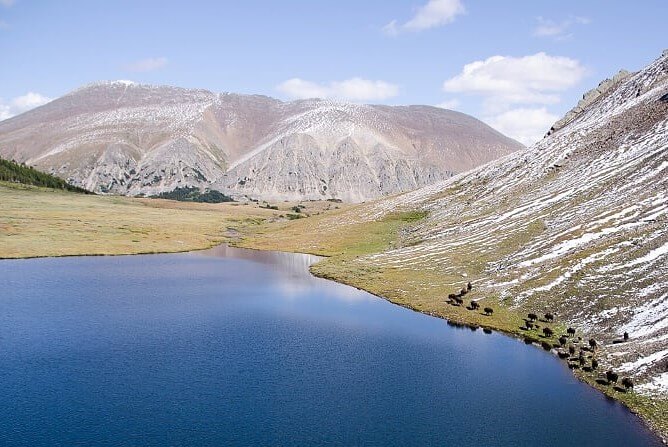
Buffalo follow single file along the edge of a lake, high in the mountains above the tree line. Photo ©Parks Canada / Banff National Park.
Recommendations include:
- a) to continue coordinating ceremonial activities;
- b) to continue facilitating Indigenous connection and stewardship of the herd and
- c) to better recognize the impact Indigenous ceremony has had to date on the success of the reintroduction.
Input also highlighted the importance of exploring Indigenous employment opportunities linked to bison stewardship programs and future opportunities for bison harvest.
On Collaboration: Working Together Toward Range Expansion
After support for a future with bison, the second most frequently heard comment was about the potential for expanding the geographical area bison occupy on the landscape.
Of comments that touched upon this topic, the majority (89%) were in support of an expanded area for bison.
Many respondents identified the importance of Parks Canada working in collaboration with the Government of Alberta and nearby stakeholders to achieve expansion of the area the herd can roam.
Specific recommendations included inter-jurisdictional efforts to facilitate a herd which can roam outside of Banff National Park.
Recommended outcomes of working together include:
a) classifying roaming bison as wildlife once they cross outside of Banff National Park;
b) establishing a buffer area around the park where the bison can roam in the same wayas within the park and
c) collaboration with the provincial government, private landowners and the federally owned Ya Ha Tinda Ranch on measures to facilitate use of lands for the herd.
How the Public Experience the Bison: Keeping the Bison ‘Wild’
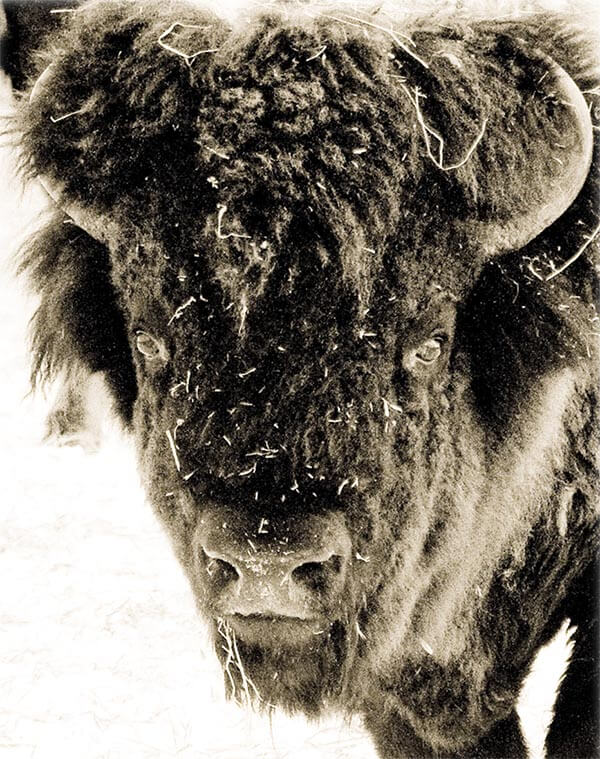
A consistent thread in the feedback stressed the need to keep Banff bison ‘wild.’ Report Cover Art Parks Canada.
Many respondents described different ways they experienced the bison herd, from personal encounters during hikes to stories shared through-out the course of the pilot garnering interest, curiosity and support.
A consistent thread in this feedback stressed the importance of keeping the bison ‘wild’ by ensuring they do not become an attraction subject to increased accessibility.
Many were concerned that increased visitation to the area and possible commercialization of the bison viewing experience may exploit the wilderness area, resulting in negative consequences to the bison themselves.
Strong sentiment against promoting visitation and sightseeing tourism was heard.

Biking trails are well marked. Photo Parks Canada.
Focus on Education
Several Indigenous Peoples, stakeholders and individuals noted the potential for enhanced educational opportunities about bison.
These comments expressed a desire for Parks Canada to improve the visitor experience through a focus on education that shares stories about the importance and role of bison and their connection to Indigenous Peoples.
There were also notable mentions about the need to increase awareness of human-wildlife safety.
A small number of respondents, including some recreational users and businesses, expressed continuing concern for their and their clients’ safety while recreating in the backcountry, especially if bison densities increase.
Environmental Interactions: Benefits to Biodiversity
A substantial number of commenters, particularly researchers, interest groups and ENGOs, spoke about the ecological and biodiversity benefits of reintroducing bison, as described in the Report.
Many support the results of the pilot because of these observations.
The strongest message heard regarding biodiversity was that the reintroduction of plains bison is vital and natural to the ecosystem, that the animals have an important ecological niche on the land and that bison have an important role as a food source for natural predators and scavengers.
While minimal, there were some concerns raised about potential negative physical effects of the herd on the land, such as the extent to which the bison have grazed some of the meadows they have favoured so far.
However, far more input focused on the fact that the pilot has had a net positive impact on the area by returning to a symbiotic relationship with bison.
To Fence or Not to Fence
Feedback was also heard regarding how fencing was used during the pilot. While some cited the Report as evidence that short sections of drift fencing effectively deflected bison while allowing other species to pass through, many commenters expressed concern for fencing as a long-term measure.
Their concerns revolved around the impacts of fencing to the movement of other wildlife and to the natural free roaming of the bison.

An older bull bison wanders a wider distance
Importance of Ongoing Monitoring
The importance of ongoing monitoring of the bison was also expressed, as was the use of scientific analysis to assess their interactions with other components of the ecosystem.
Commenters emphasized the importance of not only monitoring the herd’s progress as part of the reintroduction pilot, but also that monitoring of the bison’s impact to the landscape, their interaction with other species and their growth as central to future bison management.
On Pilot Success and the Report: A Successful Pilot
The majority of commenters believed the pilot was a success. Most respondents spoke positively about the pilot, including how it was communicated outward and about the variety of education and outreach activities that occurred throughout.
Members of the outfitter and trapper communities highlighted the open communication with the reintroduction project team as a key reason why some of their concerns lessened over the course of the pilot.
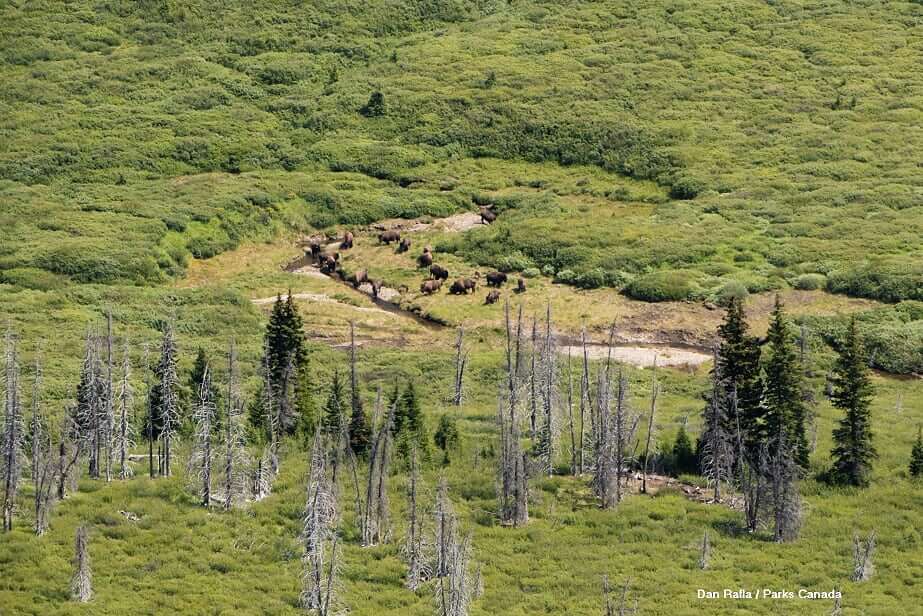
During trips into the backcountry, Forest Rangers have observed the bison herd spending less time together as a cohesive unit. Instead, smaller groups stay in separate habitat patches, which is common bison behaviour, as their population increases. The herd appears healthy and in good condition. Photo Dan Ralla/Parks Canada.
The Report
Most respondents supported the draft Report as written and were generally satisfied with the level of detail, analysis and scope of information provided.
Several detailed recommendations, however, were to expand upon or better document results of the pilot in the Report.
Feedback for improving the Report ranged from requests for the Stoney Nakoda Nation’s Cultural Monitoring and Traditional Knowledge Study to be better integrated into the Report, to wanting to see results measured against performance or management targets to better gauge success.
Many submissions also noted a need for future options or next steps to be more explicitly stated in the Report.
However, all audiences engaged expressed they are looking forward to next steps of the project and the future of bison management.
Active Future Involvement
A quarter of all respondents requested updates on and opportunities for active future involvement in the decision-making process, in project work and for continued updates as planning progresses. This was unanimous for all Indigenous Peoples.
Conclusion
In summary, Indigenous Peoples, stakeholders and the public expressed appreciation for the five-year pilot, an overall feeling that the pilot was a success and that the Report made valuable information available regarding what was learned over the course of the five-year pilot.
Support for a future with bison in Banff National Park is high.
There is great appetite for Parks Canada to take what we have learned and what we have heard to date and use that to inform a future strategy for managing the bison herd.
The insightful questions, recommendations and considerations illustrate where our attention should be directed to inform our approach moving forward.
Final Report
The final Report on the Plains Bison Reintroduction Pilot 2017-2022 has been refined and finalized based on feedback. Because of questions we received about the content of the Report, or notes about gaps in information or clarity, additional information and clarifying details have been added.
For example:
- We have endeavoured to better integrate Indigenous perspectives including
recognition of the importance of ceremony to the success of the reintroduction.
- Supplementary information to address pilot limitations and scope.
- Examples of other studies and benefits observed during the pilot.
- A high-level discussion of population observations and carrying capacities.
Moving Forward
Bison will continue to remain on the landscape within Banff National Park. Parks Canada will explore future options for bison management through development of a bison management plan.
Indigenous Peoples and stakeholders will continue to be informed and involved throughout this process. Feedback received during the engagement on the Report will continue to be considered as we move forward with next steps.
For more information:
Contact Parks Canada Banff Field Unit at opinion@pc.gc.ca
NEXT: Banff Bison—Free and Thriving (Part 2)

Francie M Berg
Author of the Buffalo Tales &Trails blog


